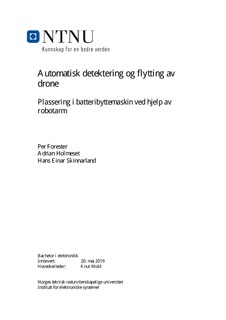Automatisk detektering og flytting av drone
Bachelor thesis
Permanent lenke
http://hdl.handle.net/11250/2617800Utgivelsesdato
2019Metadata
Vis full innførselSamlinger
Sammendrag
Forsvarets forskningsinstitutt (FFI) har en visjon om å lage en autonom dronesverm. Den skal bestå av droner opp til 250 gram og operere over lengre tid uten behov for menneskelig interaksjon. Tidligere har det blitt laget et forslag til drone og batteribyttemaskin for denne svermen.
Denne oppgaven videreutvikler dette konseptet ved å implementere en servicearm som skal kunne forflytte dronen fra en landingsplattform til batteribyttemaskinen. Servicearmen som implementeres er et av de første stegene på veien mot en servicestasjon som både kan utføre batteribytte og et begrenset vedlikehold av dronene.
Løsningen prosjektet har resultert i er et sammensatt system i stand til, helt uten menneskelig interaksjon, å lokalisere en drone på en landingsplattform for deretter å plukke den opp og plassere den i en batteribyttemaskin.Systemet kommuniserer direkte med dronen for å redegjøre orientering etter landing. Stasjonen har implementert datasyn som jobber i det infrarøde spekteret for å lokalisere dronen. Basert på denne informasjonen kan servicestasjonen selv regne ut og initiere den nødvendige bevegelsen for robotarmen til å gripe dronen og forflytte den til batteribyttemaskinen. The Norwegian Defence Research Establishment (FFI) has a long-term vision of creating an autonomous drone swarm. Consisting of 250 gram drones, it should be able to operate over a longer period of time without the need of human interaction. Previous bachelor's theses have designed a suggested drone, and battery exchanger device for the aforementioned swarm vision.
This project expands on the previous work by developing a service arm capable of picking up a drone from a landing platform, and placing it into the battery exchanger device. This service arm is one of the first steps towards a service station which is able to swap batteries, and also performing limited maintenance of the drones.
The developed solution has the ability to, without any form of human interaction, detect a drones location on a landing platform, pick it up, and place it into a battery exchanger device. The system communicates with the drone directly to get its orientation after landing. The system also employs computer vision in the infrared spectrum to locate the drone within the landing area. Based on this input the service station can calculate the necessary movement needed for the robot arm to pick up the drone, and move it to the battery exchanger device.
